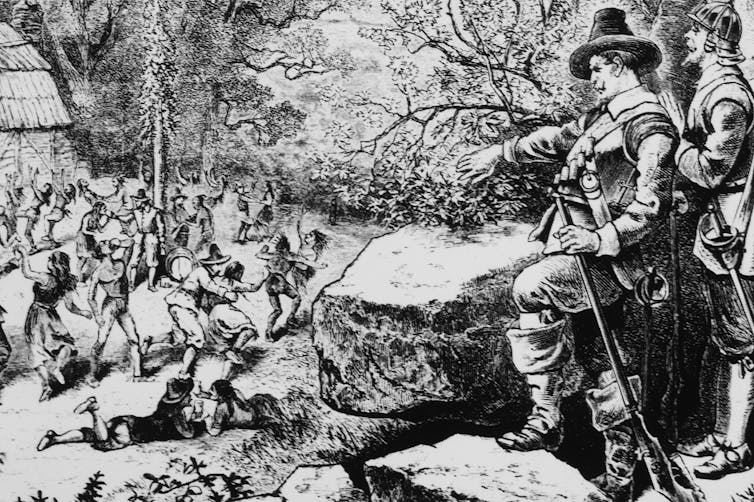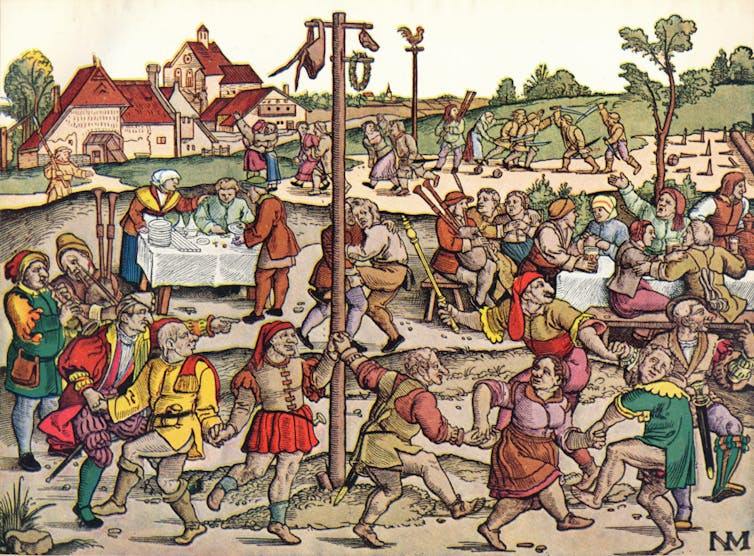Peter C. Mancall sees it as a dress rehearsal for removing Native Americans.

(Universal History Archive/Universal Images Group via Getty Images)
By Peter C. Mancall
USC Dornsife College of Letters, Arts and Sciences
 Ever since the ancient Romans decided to honor the agricultural goddess Flora with lewd spectacles in the Circus Maximus, the beginning of May has signaled the coming of spring, a time of revival after a long, dark winter.
Ever since the ancient Romans decided to honor the agricultural goddess Flora with lewd spectacles in the Circus Maximus, the beginning of May has signaled the coming of spring, a time of revival after a long, dark winter.
In Europe, the holiday – usually celebrated on May 1 – became known as May Day. Though traditions varied by country and culture, celebrants often erected maypoles and decorated them with long colorful ribbons. Townspeople, while indulging in food and drink, would frolic for hours. These rituals continue today in parks and on college campuses across the U.S. and Europe.

(Print Collector/Getty Images)
Throughout history, millions have embraced the holiday – except for the Puritans of early modern England. Though we tend to lump them together, the term “Puritans” included different groups of religious dissenters. Among them were the Pilgrims, who eventually decided to migrate to North America to create new communities according to their religious vision.
It is tempting to attribute the Pilgrims’ hostility toward the holiday to the doom-and-gloom stereotype of the Puritans as humorless and overly pious – the same tendencies that led them to ban Christmas festivities. But their attack on a maypole in Plymouth Colony in 1628 reveals much about their approach toward those who didn’t conform to their vision for the world.
Good-Natured Fun or Blasphemy?
Before they arrived in New England, some Pilgrims must have read the diatribe against May Day penned by a moralist named Philip Stubbes, who lamented the mayhem that erupted in communities across England each year as the holiday approached.
Stubbes described how eager participants would select one of the men among them to be the “Lord of Misrule,” who then led them into pits of debauchery. They would sing and dance in church, much to the consternation of devout ministers. And the participants in these rites always dragged a large tree from a nearby forest to be erected in the town, which became a symbol of their irreligious behavior.
But most in England didn’t see the holiday in such a poor light. For many, these maypoles simply represented raucous, good-natured fun. King James, who reigned from 1603 to 1625, believed that erecting such poles was “harmless” and he castigated Puritans’ efforts to quash the holiday.
In England, Puritans needed to abide by national laws, so there was little they could do to stop the celebrations outside of voicing their disapproval. More effective protests would need to wait.
Morton Becomes the ‘Lord of Misrule’
Once in New England, the Puritans believed they needed to be exemplars of proper Christian behavior. Everyone in their towns had to abide by their rules, and they punished colonists whose actions seemed to undermine devout religious practice.
As the future governor of the Massachusetts Bay Colony, John Winthrop allegedly declared the Puritans would build their “city on a hill.” Citing language from the Book of Matthew, he claimed that all of the Puritans’ actions would be visible to the entire world, including – most importantly – their God. Any departure from strict obedience to Scripture could threaten their entire mission.
The Pilgrims established their community of Plymouth on the site of the Wampanoag town of Patuxet in 1620. In the years that followed, other English migrants arrived in the region, though many eschewed the Pilgrims’ strict teachings. They came to make money from trading, not escape persecution for their beliefs.

(Culture Club/Getty Images)
A small group of these colonists moved about 25 miles northwest of Plymouth. A lawyer named Thomas Morton, who had arrived in New England in 1624 or 1625, eventually became the unofficial leader of this camp, which came to be known as Merrymount. In 1628, with Morton’s blessing, the colonists set up an 80-foot maypole crowned with deer antlers in preparation for May Day.
The maypole immediately drew the attention of Plymouth authorities. So did Morton’s antics. According to William Bradford, then the colony’s governor, Morton had become the “Lord of Misrule.” The assembled at Merrymount sang bawdy songs and invited Native American women to join them. The colonists in the small community, the governor wrote, had “revived and celebrated the feasts of the Roman goddess Flora,” which he linked to “the beastly practices of the mad Bacchanalians.”
Morton was running, in Bradford’s words, “a School of Atheism.”
Bradford claimed that Morton and his followers had fallen “to great licentiousness” and led “dissolute” lives. Rather than allow them their fun, the Pilgrims sent a group of armed men to arrest their leader. Soon they exiled Morton back to England.
The next year, John Endecott, a recent immigrant who shared many of the Pilgrims’ beliefs, chopped down the maypole, much to Bradford’s satisfaction.
Harbinger of More Destruction
Why, one might ask, would it matter that stern Puritans would want to quash a good-natured holiday? After all, given many of their other actions, felling a tall tree topped with deer antlers hardly seems worth mentioning.
But as a historian of early New England, I see Bradford’s condemnation of Morton and the destruction of the maypole as a harbinger of future violence.
When they chopped down the maypole, the Puritans believed that they were cleansing the landscape, making it more suitable for pious colonists to occupy. It was their way of demonstrating that they could live up their ideals.
Since they believed in predestination, the conviction that everything that occurs is part of a divine plan, they must have figured that God had sent Morton to test them. By exiling him and destroying the maypole, they confirmed what they saw as the righteousness of their cause.
A decade later, with tensions rising between colonists and Indigenous people, the Pilgrims of Plymouth, along with the Puritans of Massachusetts, saw themselves confronting a new test. This time the threat came not from a maypole, but instead from a Native American community that seemed, as Bradford wrote – using language that echoed his condemnation of Morton – “proud and insulting.”
The consequences in 1637 were far worse than at Merrymount. The colonists set a Pequot town aflame and shot those who tried to escape. Historians estimate that at least 400 Native Americans lost their lives in a single night.
Like other English colonizers, the Pilgrims believed they needed to displace Native Americans to create their own communities. But before they did so, they had to get their own houses in order. They could not tolerate any who crossed them, attacking those deemed a threat.
Colonial leaders like Winthrop and Bradford believed any sign of disobedience had to be punished. Clearing Merrymount of its maypole was a dress rehearsal for what was to come.![]()
Peter C. Mancall is the Andrew W. Mellon professor of the humanities at USC Dornsife College of Letters, Arts and Sciences.
This article is republished from The Conversation under a Creative Commons license. Read the original article.
The views expressed are solely those of the author and may or may not reflect those of Consortium News.
Please Support Our
Spring Fund Drive!



And thus it is that from the very inception of “New England” in these earliest suppressions of freedoms, through the many brutal wars against native peoples, on through the horrors of industrial heteronomy and slavery, to the endless self-righteous passing of harsh punitive “sanctions” against societies which are barely hanging onto life as it is, through the wholesale destruction by bombing of Hanoi, Belgrade, Fallujah, Raqqa and dozens more such places, to the tormenting conditions under which our 2.2 million never tried but merely “plea bargained” prisoners must survive their long “mandatory minimum” sentences, right up to the outrageously cruel attempt of the US Dept. of Justice to extradite an ill and frail Julian Assange that he might be further tortured by lifetime solitary confinement in a highest security prison the US state, it is invariably the unconscious “will to punish” that operates here, and in a thousand other places, to vanquish any semblance of decency, individual freedom, basic humanity, inviolable human rights, and ultimately, civilization itself.
And yet it seems, to me, that not all religions breed fanatics ?
Apparently, there are around 10,000 religions and the ones that seem to breed the fanatics are the ones that ‘worship’ human like entities. The ones that ‘worship’ the planet, the elements, animals, good behaviors seem to be more balanced, eg. Shinto. But I could be wrong. At the end of the day ALL religions have been ‘dreamed up’ by mankind, with the emphasis on ‘man’, always a basis for troubles !
Anglican’s desperation! Deflect attention away from CAVALIER Church of England crimes onto ROUNDHEAD Calvinists. Sheesh will they ever give up? Look around you today. Who is dominant? Cavaliers or Roundheads? The answer is obvious. Cavaliers are the economic lords ruling all. Calvinism is withering on the vine . In every large US city there are extremely wealthy Episcopal private schools churning out the nations best and brightest. Calvinist prep schools?
I was with you up to the point where you made a leap of ten years, between the maypole destruction and the Mystic massacre, and cited a single, vague comment by Bradford as evidence of a relationship between the two. Quite a lot happened in that decade, including the arrival of many more English settlers lusting for land, that would disturb the fragile stability of Plymouth’s relationship with native neighbors. Morton’s reported willingness to sell liquor and firearms to tribes deserves a mention because Plymouth’s leaders considered that an existential threat. Fear, we know, is a powerful motivator of extreme behavior, and greed is another. Religion does make a good smokescreen, however.
Brebeuf and Lalement, the fathers offer a corollary to the north on a different day for a different reason. Martyrdom for a god that didn’t rate in an other world.
May Day goes back much further than the short article describes. It is Beltaine, the halfway point between spring equinox and summer solstice, corresponding to Samhain (Halloween) in the fall. The maypole is the great phallus, borrowed from India, where it is still called “the great lingam.” Of course, it is the god’s phallus planted in the earth, to bring about fertility and abundant crops. According to references quoted in The Woman’s Encyclopedia of Myths and Secrets, marriage bonds in Europe were temporarily lifted and young men and women went into woods and fields to copulate – an act of sympathetic spring magic.
Psychos for Christ!….
Here are the opening paragraphs of an article which describes what fundamentalism, as manifested in whatever religion, is really all about. This includes the Puritans as described in this article.
hxxp://www.bidstrup.com/religion.htm
One might say – what changes, either within this country or without its borders (often with our financial and/or military efforts)? This no effing city on a/the hill (I was about to write “no bloody city” but that, of course, is exactly what it was and remains to this day).
Religeous fanatics are always dangerous whatever flavour they come in. At the end of the day, it’s always some egotistical, perverted type trying to exert their influence over others and using some ‘book of truth’ as their excuse to force people to bend to their extremist will.
At least in the West it seems that over the last 10 years, or more, the planet appears to have lurched to the right and the fanatics have gained more power. It won’t end well.
And it was and remains all about the $$$$$$$$$….(well, the moolah of the time, anyway) at fundament. After all, those so called followers of “Jesus” (they definitely ignored the first four books of the new testament – too bloody radical, socialist, except such a concept didn’t really exist at the time) were all about demonstrating their personal righteousness as manifested in their acquisitions, their comforts, their property and goods. They maintained undraped, uncurtained windows that those around them might see, recognize that they were bound for heaven, while those with little or nothing, in poverty were not – such was their hubristic, arrogant and fundamentally inhuman belief system. Nothing has changed here.
It seems that religious fanatics are either dangerous, or in the process of becoming dangerous to others.